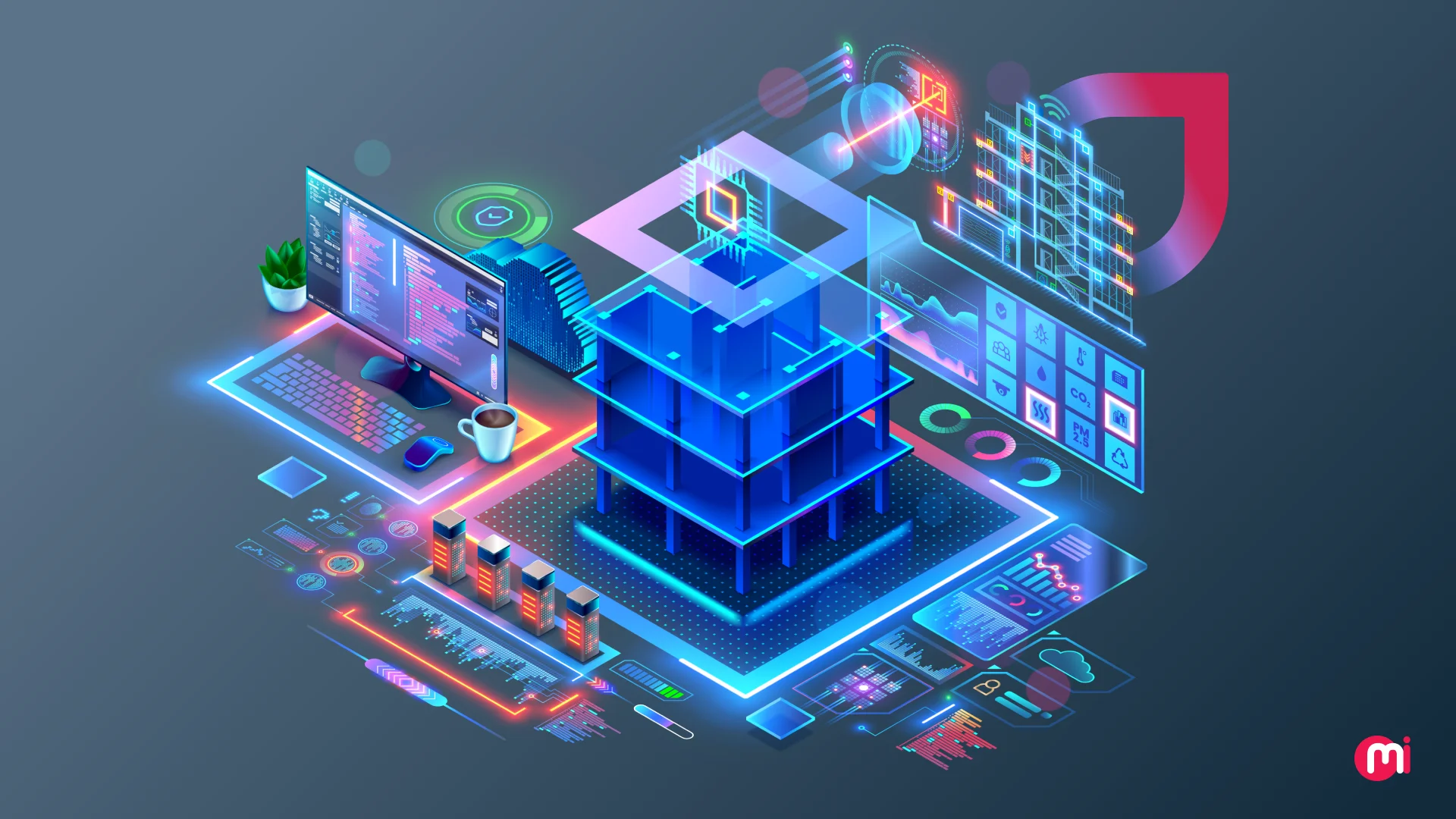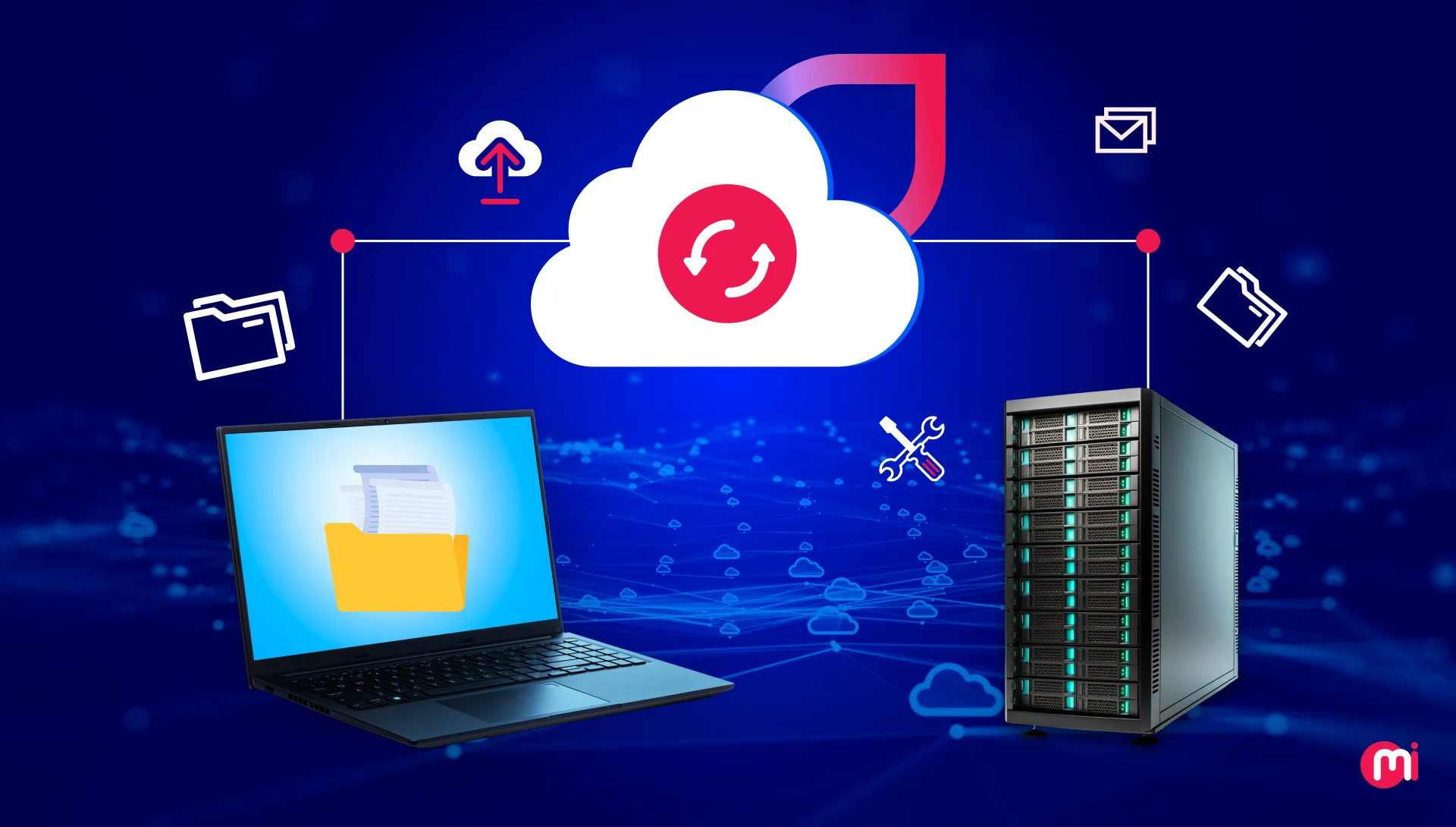14 Software Architecture Patterns to Follow in 2025
- Software
- January 27, 2025
Selecting the ideal software architecture pattern is critical to avoiding costly failures like performance bottlenecks, unmanageable technical debt, and even business collapse. With 50% of software budgets wasted on post-launch fixes due to poor architectural choices, this decision impacts both your product’s success and bottom line. Hence, we have created this blog that covers the top 14 software architecture patterns you can choose for your project.
The foundation of any successful software lies in its architecture. But what happens if that foundation isn’t right? The wrong selection of software architecture patterns can raise many challenges, including poor performance, scalability issues, skyrocketing maintenance costs, and complete system failures. Not just that, this can also lead software-driven companies to collapse. It’s the worst-case scenario any business can think of.
Imagine an e-commerce platform struggling to handle a surge in traffic during a holiday sale (black friday) or a real-time analytics tool failing to deliver insights promptly. That’s bad customer experience (CX). Because of this, 50% of the software development budget goes to maintenance services, which you definitely don’t want to spend.
Hence, it’s a must to choose the right one from the 14 best software architecture patterns discussed in this blog with pros, cons, and use cases.

What is a Software Architecture Pattern?
A software architecture pattern is your blueprint for a software system – a high-level structure that showcases the relationship between its different components, like how they interact and work together.
These types of software architecture patterns resolve common design challenges, ensuring the system is scalable, maintainable, and efficient.
To understand in a simpler manner, you can say software architecture patterns guide developers on:
- How to organize the parts of a software system.
- How these parts talk to each other (e.g., directly or through messengers).
- Whether to build one big system or break it into smaller, independent pieces.
The end goal for software architecture patterns is to ensure that the software is scalable, efficient, and easy to maintain. Our expert-led software consulting services can help to select the right one from different modern software architecture patterns.
Top 14 Software Architecture Patterns To Choose For Your Software Development Project
Know everything about different types of software architecture patterns – how they are designed, their layers and connections, when to select them, pros and cons, and real-world software architecture patterns examples. This will help you choose the right one for your software product development project:
1. Microservices Architecture Pattern
You must have heard the popular debate between Microservice Vs. Monolithic architecture pattern. But in the end, microservices architecture wins the debate when it comes to developing high-performance and scalable software solutions.
The microservices architectural pattern is a design approach where a large application is built as a suite of small, independently deployable services. In this, each service is running its own process and communicating via APIs. By mentioning processes, we mean user management, payment processing, or order fulfillment.
Hence, microservices become the #1 choice for startups scaling to the enterprise level.
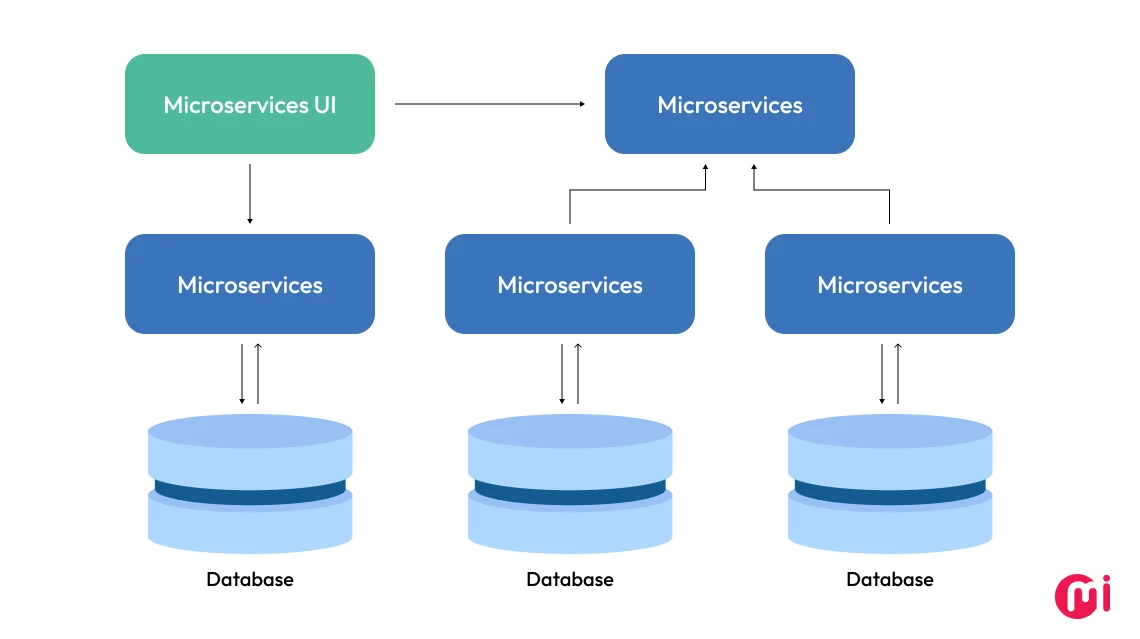
When to Use Microservices?
- Building Complex, evolving systems (e.g., SaaS platforms, enterprise software solutions)
- Teams need independent deployments (e.g., CI/CD pipelines)
- There’s requirement for mixed technology stacks (e.g., Python for ML + Java for billing)
- There are high scalability demands (e.g., e-commerce during Black Friday)
In short, Microservices are best for enterprises, scalable SaaS, and multi-team projects. Hence, it becomes one of the best choices among enterprise software architecture patterns.
Avoid Using Microservices If
- Your team is small (< 5 devs) or your project is simple (MVP).
- There’s no DevOps expertise (requires Kubernetes, Docker) in your team.
SOLUTION:
You can scale your team by opting to hire dedicated software development team and hire DevOps engineers from us.
Pros of Microservices
- Offers independent scaling – this means you can scale only the “checkout” service during peak sales, not the entire app.
- Supports faster deployments – for example, you can update the “search” service without redeploying the whole system.
- Gets you tech flexibility – this allows you to use Node.js for real-time chat + Python for performance-critical tasks.
- Provides fault isolation – this means if the “recommendations” service fails, the rest of the app still keeps running.
Cons of Microservices
- Has complex debugging – this says it’s complex to trace errors across 50+ services (need distributed tracing).
- Microservices-based software development projects are often costly, as they require Kubernetes, API gateways, and more cloud resources.
- Data consistency can be an issue here – for example, in an e-commerce store, orders might temporarily show as “pending” due to eventual consistency.
- Network latency can become a challenge here, leading to API calls between services adding milliseconds of delay.
Real-World Examples of Software Built With Microservices
- Netflix uses hundreds to thousands of microservices to manage user authentication, content catalog, recommendation engine, billing, and streaming.
- Uber separates ride-matching, payments, and ETA calculations into services with the help of microservices.
- Spotify uses microservices to keep independent services for user profiles, playlists, and analytics.
Also read: Technologies for Microservices Architecture

2. Event-Driven Architecture Pattern
An event-driven architecture is one of the leading software architecture design patterns where components communicate via asynchronous events (e.g., messages, notifications) rather than direct requests. Here, events are typically notifications of changes in state or actions, like a user clicking a button or a sensor capturing data.
Agile by core, event-driven architecture is mainly recommended to build systems for your evolving needs and high-performance demands. Software systems built using this architecture pattern are built around the generation, detection, and reaction to events.
Hence, if you’re developing a real-time app, selecting event-driven architecture works best. Plus, event-driven becomes the best software architecture for real-time data processing because it handles asynchronous data streams. All these make it perfect for digital solutions supporting live and on-demand streaming, stock trading, and IoT sensors.
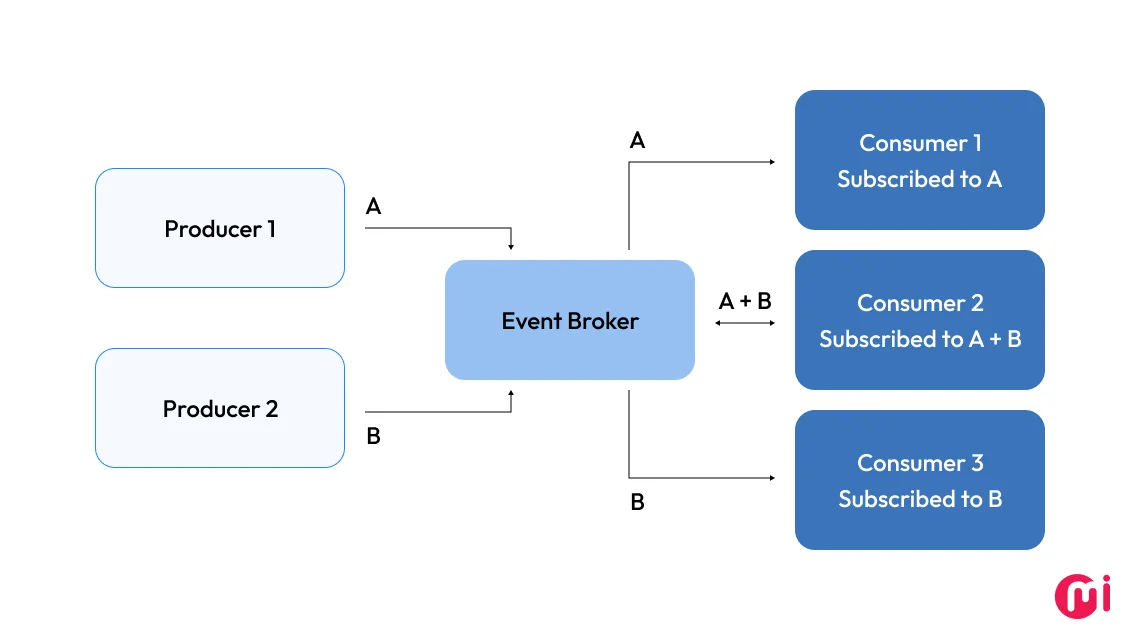
Its key components include:
- Event Producers: Generate events when specific actions or changes occur.
- Event Consumers: Respond to events by performing specific tasks or processing data.
- Event Channels: Enable communication between producers and consumers, often via message brokers or queues (e.g., Kafka, RabbitMQ).
- Event Processors: Intermediate components that process, filter, or route events before they reach consumers.
When to Use Event-Driven Software Architecture Pattern?
- Building real-time applications (e.g., stock trading, live alerts)
- Applications with high scalability needs (e.g., IoT sensor data streams)
- Software that has decoupled workflows (e.g., e-commerce: order → payment → shipping)
- Event-heavy apps (e.g., chat apps, gaming leaderboards)
Avoid if
- You need software systems with strong consistency (e.g., banking transactions).
- Your team lacks experience with message brokers (Kafka, RabbitMQ) or such API integrations.
| SOLUTION: You can opt for our custom API development and integration services. With this, you get access to professionals who are experts at integrating message brokers and customer API integrations. |
Pros of Event-Driven Architecture
- Loose coupling ensures that services don’t need to know about each other (e.g., Uber: ride request → driver dispatch → payment).
- Offers scalability, enabling software to handle 100+ events/sec.
- It has a high fault tolerance rate. That means if one service fails, events queue up and process later.
- Makes software highly responsive. For example, users get instant feedback (e.g., live sports scores).
Cons of Event-Driven Architecture
- It has a complex debugging process, just like microservices (it needs tools like Jaeger)
- There might eventually be consistency issues. For example, data may face a delay of milliseconds (e.g., order status delivery eventually arrives).
- There are also scalable challenges in event-driven architecture-based software.
- Message broker costs add up to the total cost, which also leads to infrastructure overhead.
- There might be an over-engineering risk. You can avoid using this architecture for simple CRUD apps.
Real-World Examples of Software Built With Even-Driven Architecture Pattern
- Uber uses event-driven architecture for ride matching.
- Airbnb utilizes event-driven architecture to handle a massive volume of user events and ensure a scalable, real-time, and resilient platform.
How does Uber make that happen? Read our guide to building a ride-booking app like UBER.
3. Serverless Architecture Pattern
Amidst exploring demand for cost-efficient and auto-scaling solutions for small businesses, serverless software architecture design patterns come as the ideal fit solution.
Serverless architecture is a cloud-native design where developers deploy code (typically as functions) without managing servers. The cloud provider dynamically allocates resources, scaling automatically based on demand.
It has become the favorite architecture pattern for small businesses because it supports the pay-per-use pricing model provided by AWS Lambda for periodical workloads. It’s best cost-effective software architecture pattern for startup software development solutions that may have unpredictable traffic.
When to Use the Serverless Software Architecture Pattern?
- Need to implement event-driven workloads (e.g., file uploads, IoT data processing)
- Apps may get sporadic or unpredictable traffic (e.g., marketing campaign spikes)
- Need to build rapid prototyping/MVPs (fast deployment, low upfront cost)
- Want to integrate microservices backends (independent scaling for APIs, auth, notifications)
Avoid If
- Software may have long-running processes
- You need low latency or consistent high traffic.
- Strict latency requirements
Pros of Serverless Architecture Pattern
- You have to pay only for execution time
- Auto-scaling abilities, making your software handle traffic spikes seamlessly (e.g., Black Friday sales)
- No requirement for server patching or capacity planning
- Helps to deploy applications after
- Has built-in fault tolerance thanks to cloud connectivity
Cons of Serverless Architecture Pattern
- It’s cold starts can cause initial latency (up to 5s) for inactive functions
- High possibility of vendor lock-in because of the complexity to migrate between AWS/Azure/GCP
- Debugging complexity because of distributed tracking needed for microservices
- Software may cost you more at scale because high invocation volumes can exceed VM costs.
Real-World Examples of Software Built With Serverless Architecture Pattern
- Netflix leverages serverless architecture (mainly AWS Lambda) for various tasks like video encoding, data processing, and backup management.
- Slack uses serverless architecture through AWS services like Lambda, API Gateway, and others to manage its core functionalities and integrations for better scalability.
Read our blog on building an app like Netflix to know how it leverages serverless architecture.
4. CQRS Architecture Pattern
CQRS stands for command query responsibility segregation pattern, which mainly separates read (Query) and write (Command) operations into distinct models. This segregation helps it to optimize performance and scalability for data-intensive applications.
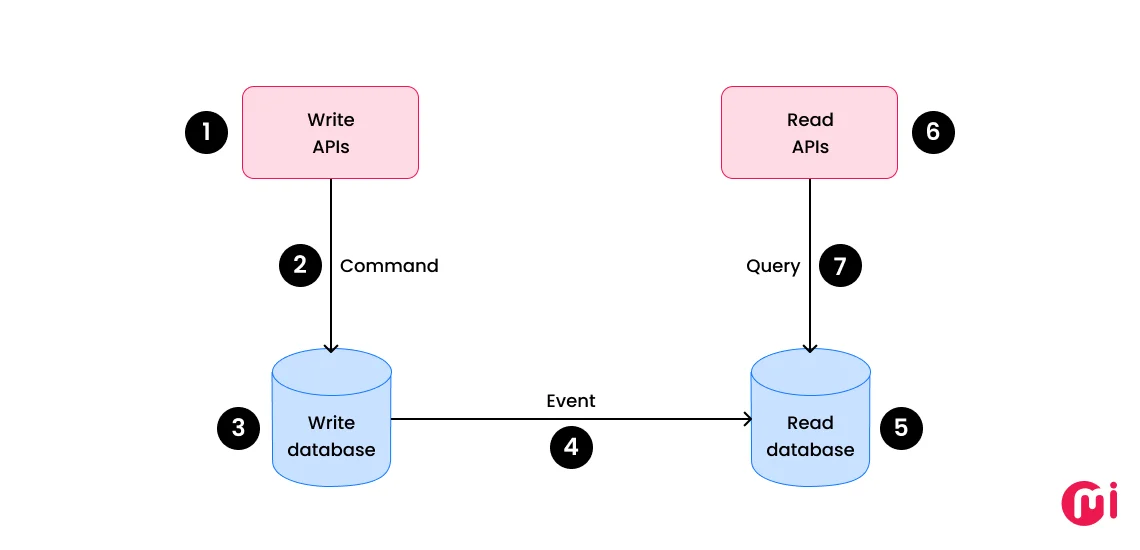
There’s been a high growth in demand for using the CQRS architecture pattern for data-heavy applications since AI integration services and data & analytics services became necessities in this digital world of personalization.
When to Use CQRS?
- High-read systems (e.g., dashboards, reporting tools with 10x more reads than writes)
- Complex domains where reads/writes need different optimizations (e.g., e-commerce: product listings vs. order processing)
- Event-sourced systems (paired with Event-Driven Architecture for audit trails)
- Teams needing independent scaling (e.g., scale read databases separately)
Avoid using CQRS if
- Your app is simple CRUD (e.g., a basic CMS solution with equal reads/writes).
- You require strong consistency (e.g., banking transactions where balance must be instantly accurate).
Pros of CQRS
- Optimized performance as its Read operations use denormalized data (resulting in fast queries); writes avoid complex joins.
- Independent scaling is possible, like reading NoSQL databases and writing databases (SQL) separately.
- Flexibility is a plus point when needing to use different storage tech per model.
- Team parallelism is the biggest advantage, as frontend and backend teams can work independently using this software architecture pattern on read/write models.
Cons of CQRS
- Complexity is there because of dual models and double codebases, increasing testing and debugging efforts.
- Eventual consistency can be at question as read models may lag behind writes.
- Requires message brokers (like Kafka) for syncing models and reducing overhead.
Real-World Examples of Software Built With CQRS Architecture Pattern
- X (formally known as Twitter) may be using the CQRS pattern for better platform scalability and optimization.
5. Layered Architecture Pattern
Also known as the N-tier architecture pattern, the layered architecture pattern is popular amongst designers and software architects. Plus, it’s popular amongst the best basic software architecture patterns, specifically for Java EE applications. Not to forget, layered is the cost-effective architecture pattern for small businesses as it has a low upfront cost and is simple to deploy (e.g., building an MVP for a local bakery’s CMS).
It organizes software into multiple layers, each responsible for a distinct set of tasks or functionalities. As one layer is stacked above others, each layer communicates with the layer stacked above or below it, which helps in promoting modularity, maintainability, and separation of concerns.

Its different layers include:
- Presentation Layer: This is where we all, as users, interact with the software interface and get information upon prompted requests.
- Business Layer: It handles all business-level operations, validations, and logics and is responsible for executing such upon request.
- Persistent Layer: It acts as a mediator between business and database layers, which manages operations like object-relational mapping.
- Data Layer: An independent layer from the application server and business logic interference that manages data operations.
When to Use Layered Architecture Pattern?
- Simple to medium-complexity applications (e.g., internal tools, basic CRUD apps).
- Teams with clear role separation (e.g., frontend vs. backend developers).
- Projects needing straightforward maintenance (well-defined layers reduce spaghetti code (the one that is messy, unstructured, and difficult-to-understand software code)).
- Educational purposes (easy to teach/learn foundational concepts).
Avoid Using Layered Architecture Pattern If
- You’re building highly scalable or real-time systems (in that case, microservices work better)
- You need independent scaling of components (as the layered structure can make it tightly coupled)
Pros of Layered Architecture
- Easy to understand and implement, making it ideal for beginners.
- UI, business logic, and data access are cleanly divided.
- Layers can be tested independently.
- Minimal infrastructure needs compared to distributed patterns.
Cons of Layered Architecture
- Performance bottlenecks may arrive as each request coming to it must pass through all layers, which adds up to latency.
- Scalability limits may be there as the entire app must scale together.
- Tight coupling makes it hard to update one layer without affecting others.
- Business logic often leaks across layers over time.
Real-World Examples of Software Built With Layered Architecture Pattern
- SAP is built around layered architecture (three-tier: presentation, application, and database) for better flexibility, scalability, and ease of maintenance.
- Apache Struts uses a layered architecture pattern (MVC (Model-View-Controller) specifically) for better maintainability, testability, and extensibility.
Also read our blog on web application architecture to gather more information on selecting the MVC pattern.

6. Hexagonal (Ports/Adapters) Architecture
Also known as the Ports and Adapters pattern, Hexagonal architecture pattern helps to create loosely coupled component-based applications. Because of this feature, applications work independently with no dependency on data stores or UIs or for testing approaches.
Being one of the clean architecture examples, hexagonal architecture gives businesses flexibility to change technology stacks over time with little to no impact on business, offering long-term reliability.
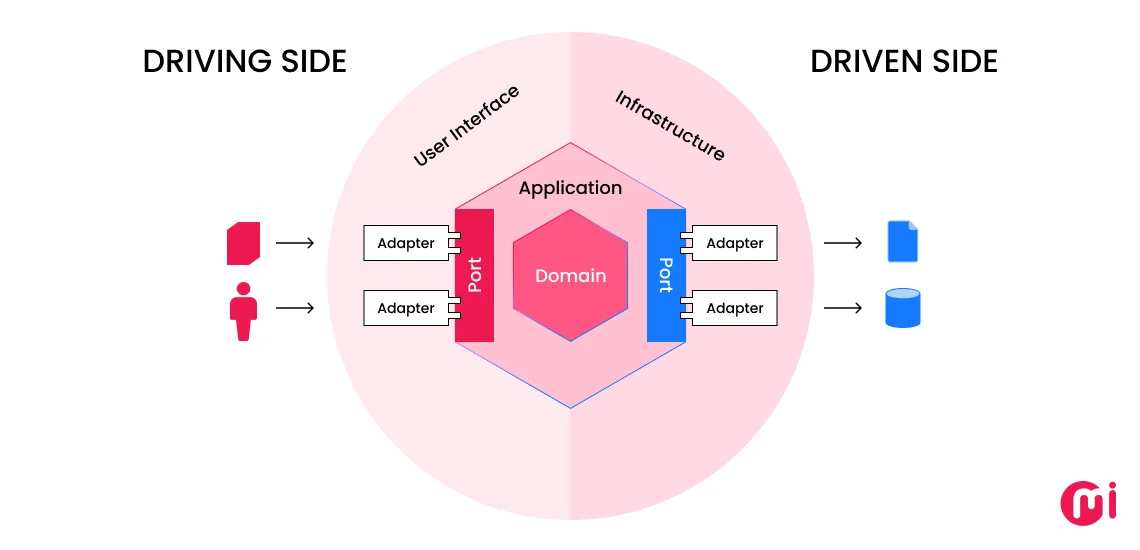
Core Components:
- Domain (Core): Contains business logic and rules with no dependencies on external systems
- Ports: Inbound (Driving) defines how users interact with the core, and Outbound (Driven) describes how the core interacts with external services.
- Adapters: Primary ones translate HTTP requests into core-understandable commands, while secondary ones implement outbound ports
Hence, the Hexagonal architecture pattern is gaining traction for maintainable, testable systems.
When to Use the Hexagonal Architecture Pattern?
- Complex domains with evolving business rules (e.g., e-commerce, banking).
- Multi-channel systems need to support APIs, UIs, and batch processing.
- Frequent technology changes (e.g., swapping databases or frameworks).
- High testability requirements (unit testing core logic in isolation).
Avoid Using Hexagonal Architecture Pattern If
- Building simple CRUD apps (overkill for minimal logic)
- Tight deadlines (initial setup adds complexity)
Pros of Hexagonal Architecture
- Better testability
- Flexibility in swapping technologies
- Maintainability, as changes to UIs/databases don’t require core logic updates.
- Business rules remain independent from technical details
Cons of Hexagonal Architecture
- Initially complex to design ports/adapters (steep learning curve)
- Boilerplate code (the ones used in the project repeatedly) of adapters adds extra layers
- Additional abstraction layers add up to performance overhead.
Real-World Examples of Software Built With Hexagonal Architecture Pattern
- Netflix also uses hexagonal architecture in conjunction with microservices to have a high degree of flexibility and decoupling.
- PayPal uses this to separate transaction processing logic from APIs and UIs while keeping its business logic pure.
7. Space-based Architecture Pattern
Space-based architecture pattern is also known as cloud-based architecture or tuple-space architecture (a shared memory model where services communicate through tuple addition, deletion, or reading). This is a distributed computing pattern that makes it one of the best software architecture patterns for real-time data processing. This handles high traffic and scalability challenges by splitting application workloads across multiple instances.
Here, the term “space” refers to the virtualized data grids that act as shared memory space for all application components, enabling efficient communication and collaboration between services.
These virtualized data grids are also known as in-memory data grids (IMDG) that process and store transient data. Here, an in-memory data grid is a distributed system that stores data in the RAM of multiple servers, rather than on disk, to provide ultra-fast access to large volumes of data.
So, there will be less reliance on databases, resulting in reduced latency and bottlenecks associated with legacy database-centric designs.
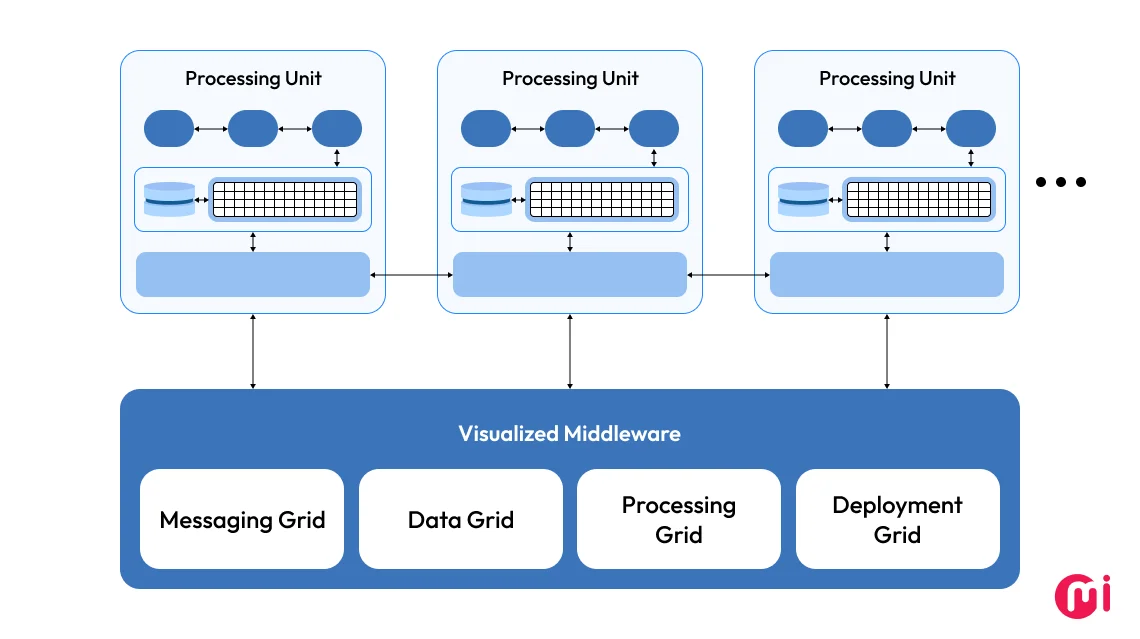
When to Use Space-based Architecture Pattern?
- Real-time data processing (e.g., stock trading, fraud detection)
- High-concurrency systems (e.g., e-commerce sales, auction platforms)
- Scalable application with variable workloads (e.g., seasonal traffic spikes in retail)
- Fault-tolerant applications (e.g., healthcare monitoring systems)
Avoid Using Space-Based Architecture If:
- Your app has low user volume (overkill for simple CRUD)
- You require strong data consistency.
Pros of Space-Based Architecture Pattern
- Supports near-linear scalability (horizontal scaling by adding PUs)
- Delivers low latency applications thanks to in-memory data accessibility
- High fault tolerance of applications where PU failures don’t crash the system but rather replicate data across nodes.
- Offers cost efficiency as it reduces expensive database calls and optimizes resource use.
Cons of Space-Based Architecture Pattern
- Requires expertise in distributed systems and tools like Apache Ignite or Hazelcast.
- Data replication delays may cause temporary inconsistencies.
- Testing challenges will be there, as simulating high-load scenarios is costly and time-consuming.
Real-World Examples of Software Built With Space-Based Architecture Pattern
- Amazon shopping app uses space-based architecture pattern to handle traffic spikes by dynamically scaling PUs
- LMAX uses this pattern for high-speed trading experiences.
8. Client-Server Architecture Pattern
Connected by two main entities – client and server – this architecture pattern creates a system that hosts, delivers, and manages resources upon request. The client and server typically communicate over a network, and they may be located on different machines or even in different geographical locations.
This architecture creates a clear division of labor where the client handles the user interface and the server handles data management, business logic, and processing.
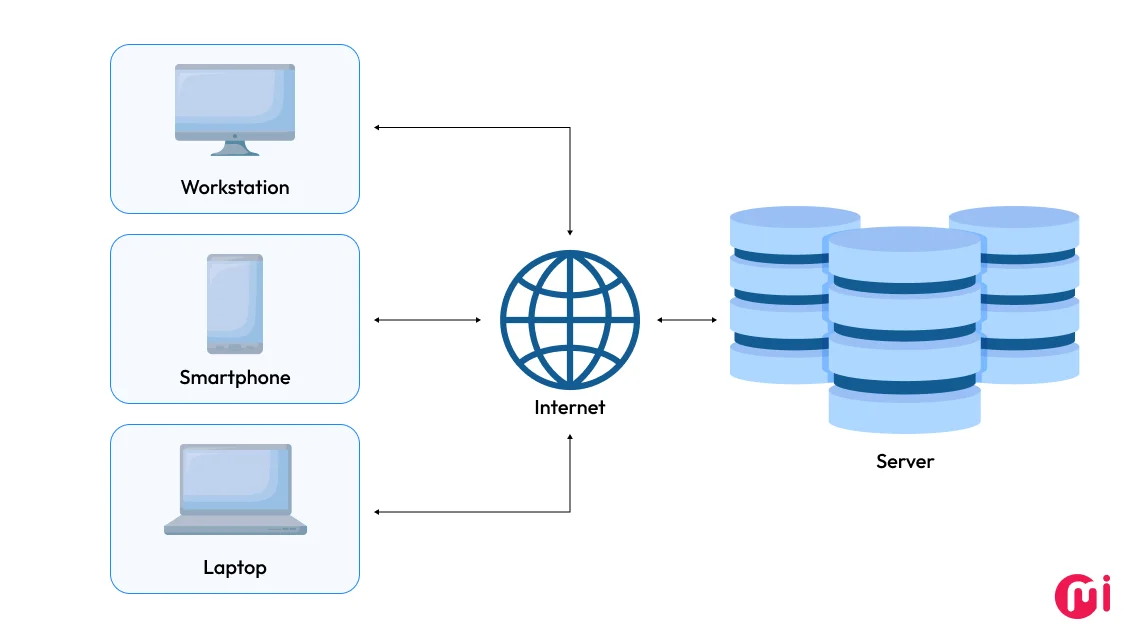
When to Use the Client-Server Architecture Pattern?
- Developing web applications (e.g., e-commerce platforms, CMS, and social media sites)
- Building systems where multiple clients need access to centralized resources or services (e.g., ERP systems, CRM solutions, and cloud-native application solutions)
- Developing network-centric applications (e.g., chat applications and file-sharing platforms)
- Building real-time or on-demand data access-based applications.
Avoid using the Client-Server Architecture Pattern If
- You need offline functionality (like we enabled in 6PP app built for America’s one of the leading physical therapist and strength/conditioning coaches, Jeff Cavalier)
- Building decentralized systems.
Pros of Client-Server Architecture Pattern
- Provides centralized control for data
- Prioritizes security at most with authentication/encryption
- Scales servers independently
- Updates server logic without client changes
Cons of Client-Server Architecture Pattern
- Systems relying on real-time or low-latency responses may face significant issues.
- Might not be a good fit for systems that demand real-time communication with ultra-low latency.
- Server downtime may disrupt all clients.
- At peak load time, the system may slow down or crash in worst-case scenarios.
- If a data breach happens, it can expose all client data, leading to trust issues and regulatory non-compliance.
- A proper synchronization mechanism is needed to avoid inconsistencies in shared data.
Real-World Examples of Software Built With Client-Server Architecture Pattern
- Gmail and Outlook like email clients are designed with this architecture pattern
- Google Docs and Microsoft Office 365 like file storage services utilize the client-server architecture pattern to allow users to store files on servers and access them from various devices.
Want to leverage the client-service architecture pattern to build your custom ERP solution? Check our ERP development services for more information.
9. Event Sourcing Pattern
Event sourcing is an architecture pattern that captures all changes to the application state as a sequence of immutable events, stored in an append-only log. It communicates to databases, web servers, and target systems by sending a continuous stream of messages.
This feature makes it suitable for applications that deal with real-time data. It also enables audit trails, temporal queries, and complex business logic replies.

When to Use the Event Sourcing Architecture Pattern?
- Building audit-critical systems (e.g., banking, healthcare)
- Require temporal data analysis (e.g., “Show account balance at any past date”)
- Building software to manage complex business workflows (e.g., order fulfillment with rollbacks)
- For CQRS implementations (combines powerfully with Command Query Responsibility Segregation)
Avoid using the Event Sourcing Architecture Pattern If
- Your app has simple CRUD operations with no audit needs
- You prioritize immediate consistency over eventual consistency
- Your team lacks domain-driven design (DDD) expertise
Pros of Event Sourcing Architecture Pattern
- Good for applications providing complete audit trail (e.g., “Why was this transaction declined on March 12?”)
- Offers business flexibility in terms of adding new projections without migrating data
- Has debugging superpowers to replay events to reproduce bugs
- Works in synergy with CQRS to optimize reads separately from writes.
Cons of Event Sourcing Architecture Pattern
- Has a steep learning curve as it requires shift from CRUD mindset to event-based thinking
- Version handling is a complex task, as it requires managing versions when event structure changes
- Rebuilding state from millions of events requires snapshots
- Storage costs more with growing event logs
Real-World Examples of Software Built With Event Sourcing Architecture Pattern
- Git uses this pattern for version controlling
Apart from that, financial solutions use this system to store every transaction data as immutable events for compliance and to support chargeback investigations. E-commerce platforms can also utilize this to track a full history of order changes.

10. Circuit Breaker Architecture Pattern
Inspired by electric circuit breakers, this one of the modern software architecture patterns, circuit breaker, prevents cascading failures (where one failure can cause another, leading to a chain reaction) in distributed systems. It does that by temporarily blocking requests to failing services.
This feature of the circuit breaker pattern makes it an ideal fit to use in conjunction with microservices-based applications. It helps the software to be more fault-tolerant.
When to Use a Circuit Breaker Pattern?
- Microservices ecosystems (e.g., e-commerce checkout calling payment service)
- External API dependencies (e.g., weather service in a travel app)
- Mission-critical systems where failures are expensive (e.g., healthcare APIs)
Avoid using the Circuit Breaker Architecture Pattern If
- Your system has no external dependencies
- You prioritize request completion over system stability
Pros of Circuit Breaker Architecture Pattern
- Isolates failing services to protect the broader system
- Provides fallback responses (e.g., cached data) during outages
- Automatically retries after timeout periods
- Clear failure states for ops teams (e.g., dashboard alerts)
Cons of Circuit Breaker Architecture Pattern
- It has configuration complexity, which asks for testing to tune thresholds (failure count, timeout)
- Added logic slightly increases response time
- State management is difficult in distributed serverless environments
Real-World Examples of Software Built With Circuit Breaker Pattern
- Hystrix, a Netflix-developed library, is built upon the circuit breaker pattern that offers streaming service resilience.
- Amazon leverages the circuit breaker pattern to manage transactions and dependencies on external APIs at scale.
11. Sidecar Architecture Pattern
In the category of modern software architecture patterns, sidecar is a cloud-native software design pattern in which a container is applied to run alongside a primary application container, that too, without modifying core logic.
Here, a container can carry additional functionalities like logging, monitoring, security, or data synchronizing to be integrated with the primary application.
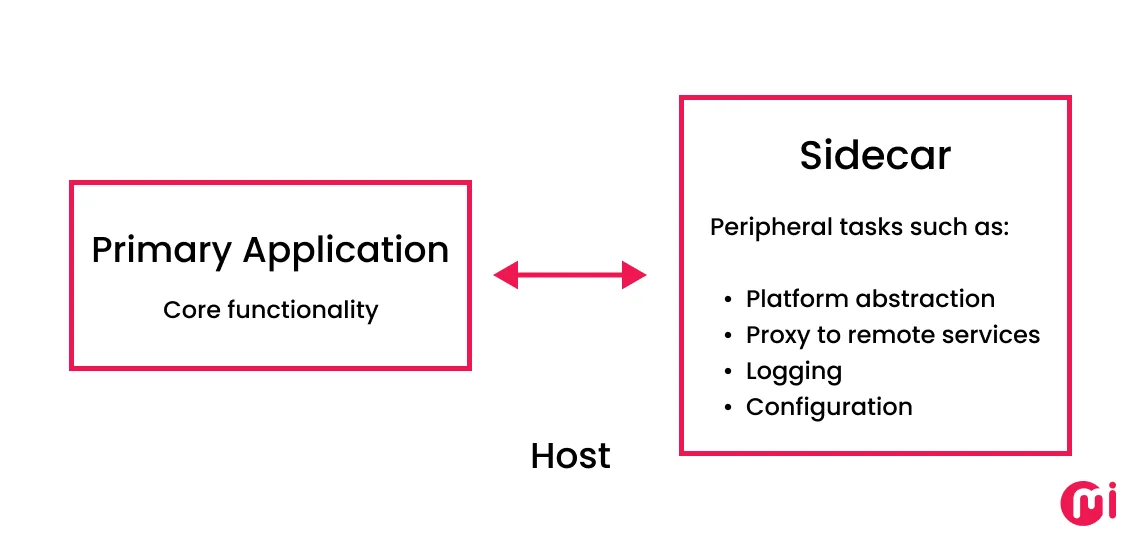
Sidecar pattern acts like a “co-pilot” to your main service, handling cross-cutting concerns like logging, security, and monitoring. The demand for this software architecture pattern is growing with cloud-native adoption.
When to Use a Sidecar Pattern?
- Service mesh implementation
- Legacy system modernization processes (adding telemetry to old apps without code changes)
- Implementing multi-language environments (e.g., Java app with Python-based ML sidecar)
- Infrastructure offloading (SSL termination, rate limiting)
Avoid using the Sidecar Pattern If
- Your app is monolithic with simple needs
- You can’t tolerate minor latency overhead (~5-15ms per call)
Pros of Sidecar Pattern
- Core app stays clean while sidecars handle service discovery phase (e.g., Consul), mutual TLS (Transport Layer Security) (e.g., Istio), Metrics collection (e.g., Prometheus)
- Makes incremental adoption possible by adding multiple sidecars to specific service list
- Enforce uniform logging/security across polyglot services
- Attach sidecars to legacy apps for cloud-native features (this may require opting for expert cloud integration services)
Cons of Sidecar Pattern
- Resource overhead can arise as each service instance needs its own sidecar
- Need distributed tracing to follow requests across sidecars
- Service mesh solutions (Istio) have steep learning curves
Real-World Examples of Software Built With Sidecar Pattern
- Kubernetes utilizes sidecar as its service mesh architecture
- Istio uses sidecars to proxy traffic between services.
- Dapr leverages sidecars for its runtime.
12. Microkernel Architecture Pattern
In gist, Microkernel Architecture decouples core features from plug-ins for modularity.
Also known as plug-in architecture, the microkernel architecture pattern consists of two entities: the core system functionalities (microkernel) and specialized features (plugin modules).
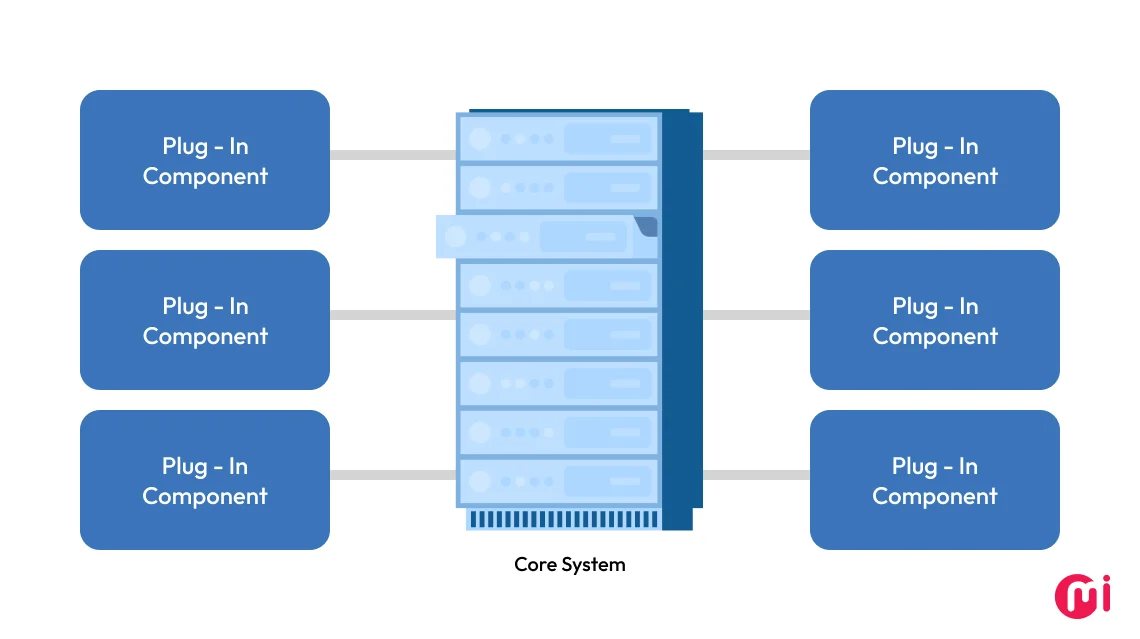
The core system focuses on essential functionality to maintain operations, while plug-in modules are standalone components designed for specialized tasks. Hence, the microkernel pattern is specific to modular apps (e.g., IDEs).
Moreover, Microkernel architecture pattern is known for being a cost-effective architecture pattern for small businesses. That’s that because it adds features incrementally without full rewrites (e.g., a small SaaS tool).
When to Use the Microkernel Architecture Pattern?
- Systems requiring high modularity and extensibility (e.g., automotive OS, IoT devices)
- Building software product solutions with evolving features (e.g., IDEs like Eclipse, CMS like WordPress)
- Scenarios where feature updates or changes are frequent but shouldn’t disrupt core operations.
- Functionality varies significantly between users or deployments.
- It’s critical to separate the core from additional features to ensure stability.
- Security-critical systems (e.g., QNX in automotive ADAS) (for this, opting for cloud security services may help)
Avoid Using Microkernel Architecture Pattern If
- Building high-performance monolithic apps
- Tight deadlines for developing simple CRUD apps
Pros of Microkernel Architecture Pattern
- Plug-ins can be added/removed without core changes
- Plug-in failures don’t crash the core
- Minimal kernel attack surface
- Plug-ins tested in isolation
Cons of Microkernel Architecture Pattern
- There might be integration challenges between the core systems and multiple plug-ins.
- There might be performance overhead issues.
- Requires careful contract design and versioning
- Plug-ins may have interdependencies, creating complexity in versioning and updates.
- Managing plug-ins can lead to higher memory and processing usage, especially in resource-constrained environments.
- Core system can become a bottleneck for distributed apps.
Real-World Examples of Software Built With Microkernel
- Eclipse IDE uses this plugin-based architecture to extend its functionalities
- WordPress/Drupal leverages this to extend its CMS functionality via themes/modules.
- Apple macOS uses this to isolate drivers/services in user space
Need help choosing the right software architecture for your CMS solutions? Check our CMS development services.
13. Pipe-Filter Architecture Pattern
More like event-driven and microservices architecture patterns, pipe-filter breaks tasks into smaller chunks/sequences of processing steps known as filters, connected by channels called pipes.
Here, each filter performs a specific data operation and passes it to the next in-line filter via a pipe in a streamlined manner. Hence, this type of software architecture pattern is often used for streamlining data processing workflows and creating modular, reusable components.
Because of this, it eases down the software maintenance and offers better scalability and reusability, flexibility in workflow, and better fault isolation.
Learn More: What is Software Maintenance?
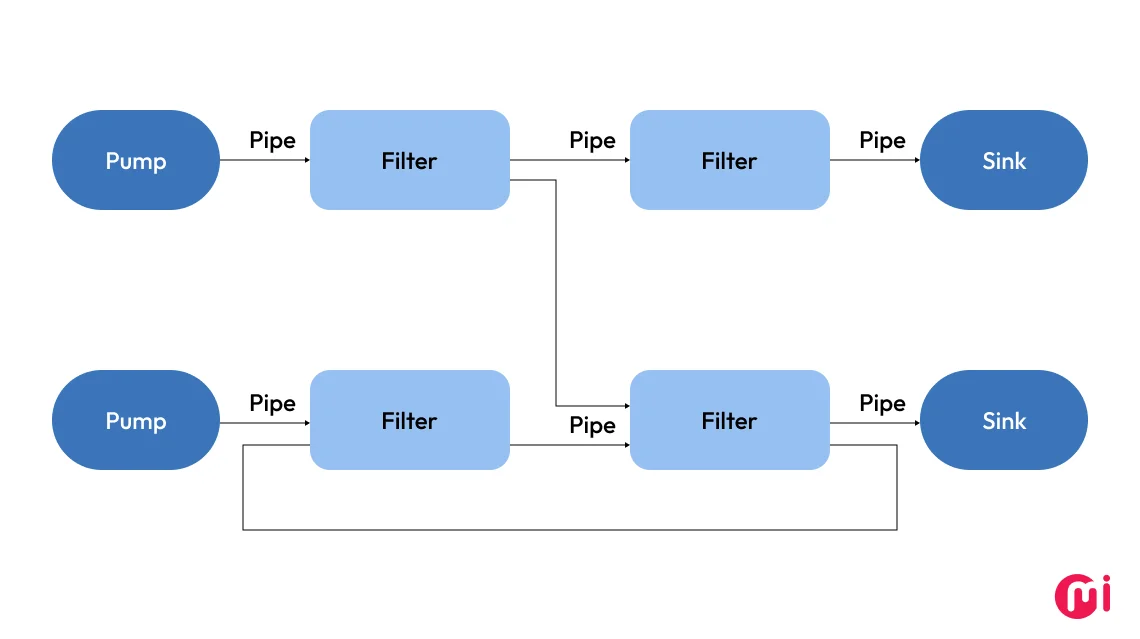
When to Use the Pipe-Filter Pattern?
- Building software systems where data needs to pass through a sequence of transformations or operations.
- Ideal for applications requiring continuous processing of data streams (e.g., log analysis, real-time analytics).
- Modularity/reusability needs
- Efficient for tasks like log file analysis or report generation, where data is processed in stages.
- Building applications dealing with parallelizable workloads (e.g., image/video processing).
Avoid Using Pipe-Filter Pattern If
- Building low-latency or real-time applications
- Complex inter-filter communication is needed
- Dynamic workflow changes are frequent
- Tight resource constraints exist
- You need fine-grained error handling
- Filters need external triggers
Pros of Pipe-Filter Architecture Pattern
- Each filter (processing step) is self-contained, making the system easier to develop, understand, and maintain.
- Filters are reusable across different pipelines or applications since they are designed to be independent and stateless.
- New functionalities can be added by simply inserting new filters into the pipeline without affecting the rest of the system.
- Filters can be run concurrently if designed properly, improving performance on multi-core systems.
- The linear flow from input to output makes the architecture predictable and easy to trace/debug.
Cons of Pipe-Filter Architecture Pattern
- Data serialization/transfer between filters adds latency
- Error handling across distributed filters is challenging
- State management is difficult due to its stateless design
- Applications may suffer from high memory usage, as each pipe may involve buffering of data.
- Data format dependency.
- Requires a high-performance CPU and good memory.
- Adding, removing, or modifying filters in a pipeline may require significant reconfiguration and validation efforts.
Real-World Examples of Software Built With Pipe-Filter Software Architecture Pattern
- Unix/Linux CLI fundamentally utilizes this to process a stream of data sequentially.
- Adobe Premiere Pro’s video effect pipelines leverage this architecture pattern
- Apache NiFi leverages this pattern for data transformation through ETL architecture
Because of these characteristics of Pipe-Filter architecture pattern, you can consider it specialized for data pipelines managed through big data analytics services.
14. Peer-to-Peer Architecture Pattern
The peer-to-peer (P2P) architecture patterns consist of peers, where each peer is built of a server and client as a decentralized entity. Instead of being connected to a centralized server, each peer is connected with other peers to share resources, data, and services.
Decentralization, direct communication, scalability, resource sharing, and fault tolerance are the key characteristics of this P2P software architecture pattern.
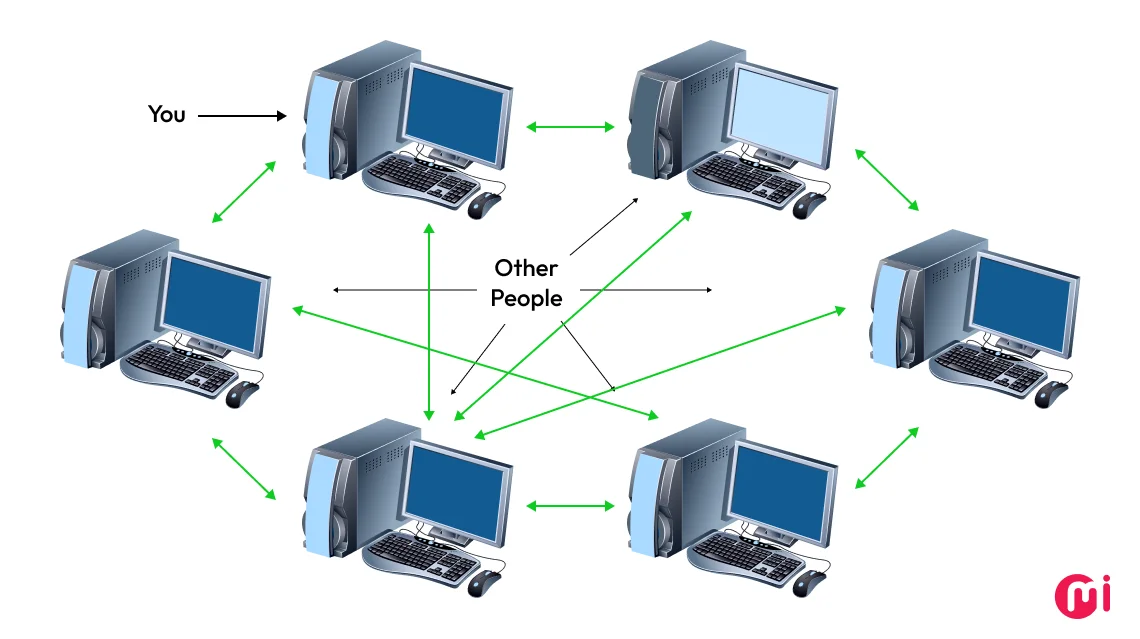
When to Use Peer-to-Peer Software Architecture?
- Building applications that need to avoid central control.
- There are high fault tolerance requirements.
- Building platforms where participants frequently join or leave.
- Requiring distributed collaboration within the system.
Avoid Using Peer-to-Peer Software Architecture If
- Centralized control is required
- Low latency and predictable performance are critical
- Security and trust are a major concern
- Regulatory compliance is critical
Pros of Peer-to-Peer Software Architecture
- System built with this are more resilient as there’s no central server
- P2P networks scale efficiently
- Each peer contributes to the overall system performance
- Eliminates the need for expensive central servers or infrastructure.
- Users are in control of their own data and participation.
- Redundant data storage across multiple peers increases reliability.
- Some P2P systems (like mesh networks) can operate without an internet connection
Cons of Peer-to-Peer Software Architecture
- Lack of high-quality services.
- It can be challenging to ensure the robust security of a software system.
- Performance of the architecture may be lacking as more nodes join.
- Complex to manage distributed resources.
- Ensuring system availability and service continuity becomes difficult.
- There are legal and compliance risks associated.
Real-World Examples of Software Built With Peer-to-Peer Software Architecture
- BitTorrent, a decentralized system, where users (peers) directly share files with each other rather than relying on a central server.
- Minecraft (modded servers or LAN play) utilizes P2P architecture for multiplayer over local network setups.

How to Choose the Right Software Architecture Pattern – Analysis for Software Development
Choosing the right architecture pattern for your software development projects requires careful analysis. Hence, here, we tried to provide a quick analysis for choosing the right software architecture pattern that can do your comparison work. Let’s have a look:
| Scenario | Recommended Patterns | Key Considerations |
| Scalable, complex systems (e-commerce, SaaS) | Microservices, Event-Driven, Serverless | Team expertise in DevOpsInfrastructure costsAsynchronous communication needs |
| Real-time processing (IoT, trading) | Event-Driven, Space-Based, CQRS + Event Sourcing | Low latencyHigh concurrencyEvent history/audit needs |
| Cost-effective MVP/startups applications | Layered, Serverless, Microkernel | Low upfront costsPay-as-you-go pricingSimple to moderate complexity |
| Modular/extensible apps (IDEs, CMS) | Microkernel, Hexagonal, Pipe-Filter | Plugin supportAdaptability to tech changesData pipeline design required |
| Fault tolerance | Circuit Breaker, Microservices | Preventing cascading failuresOffers resilient service design |
| Data-heavy apps (analytics, dashboards) | CQRS, Event Sourcing, Pipe-Filter | Read/write separationAudit trailsData transformation workflows |
| Decentralized systems (file sharing) | Peer-to-Peer (P2P) | No central server requiredResource sharingSecurity challenges |
| Cloud-native apps | Serverless, Sidecar, Microservices | Cloud integration (AWS/Azure)ContainerizationAuto-scaling |
| Legacy system modernization | Sidecar, Microservices | Adding features without rewrites is possibleIncremental cloud adoption |
| High-concurrency systems (auctions) | Space-Based, Event-Driven | In-memory data gridsReal-time processingHorizontal scaling |
Well, the selection of the right one from diverse types of software architecture patterns also depends on which one of the software development trends you’re following.
Also Read: Software Design Patterns.
Conclusion
Choosing the right software architecture pattern isn’t just a technical decision but a strategic business move. The patterns we’ve explored, from Microservices for enterprise scalability to Serverless for cost-efficient startups, each solve unique challenges while introducing tradeoffs. Just like architecture, selecting appropriate software development models is also crucial to align the development process with your project goals and business needs.
At MindInventory, we’re here to guide you every step of the way. From the discovery phase of the software development to selecting the ideal architecture, designing and developing your solution, rigorous testing, launching, and even post-launch support—we’re your trusted partner throughout the journey.
Why partner with us? MindInventory has earned a reputation as a leading software development company with a proven track record of delivering high-performing solutions. Our solutions empower millions of users, enabling seamless operations and measurable success.

FAQs About xSoftware Architecture Pattern
Event-Driven and Space-Based patterns are the fastest for high-traffic apps. Event-Driven handles real-time data efficiently, while Space-Based uses in-memory caching for ultra-low latency (e.g., stock trading apps). Microservices also scale well but add network overhead.
Event-Driven Architecture is ideal for IoT, enabling real-time sensor data processing (e.g., smart homes). Microservices allow modular updates, while Serverless reduces backend management.
Top 3 patterns for financial systems include
#1. Event Sourcing – Tracks every transaction for audits;
#2. CQRS – Separates reads (fast queries) and writes (secure processing); and
#3. Microservices – Isolates risks (e.g., fraud detection).
Software architecture patterns define the high-level structure of systems, while design patterns focus on the specific implementation. Architecture patterns handle large-scale components, whereas design patterns address finer details like entity behavior and relationships.
A monolithic architecture is a single, unified application where all components are tightly integrated and run as one. It’s simpler to develop initially but can become difficult to scale and maintain as the system grows.
In contrast, a microservices architecture breaks down the application into smaller, independent services, each responsible for a specific function. This approach allows for greater scalability, flexibility, and easier updates, but it’s more complex to set up and manage
Yes, switching architecture patterns during software development is indeed possible. However, it comes with certain considerations and implications. So, to make that possible, you need to consider the feasibility of switching patterns:
For example, in the early stage, it’s more feasible to switch architecture patterns when fewer dependencies have been established.
In the mid to late-development stage, changing the underlying architecture patterns can lead to significant refactoring as the codebase can become more complex.
1. When there are new developments in insights suggesting to switch.
2. When the current performance metrics indicate that the current architecture isn’t meeting expectations.
3. When maintainability can be an issue.
Yes, significantly. Different patterns offer varying degrees of scalability based on how they manage resources, data, and component interactions.
